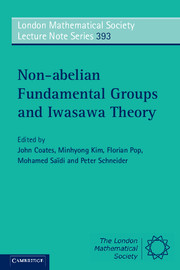Book contents
- Frontmatter
- Contents
- List of contributors
- Preface
- Lectures on anabelian phenomena in geometry and arithmetic
- On Galois rigidity of fundamental groups of algebraic curves
- Around the Grothendieck anabelian section conjecture
- From the classical to the noncommutative Iwasawa theory (for totally real number fields)
- On the MH(G)-conjecture
- Galois theory and Diophantine geometry
- Potential modularity – a survey
- Remarks on some locally ℚp-analytic representations of GL2(F) in the crystalline case
- Completed cohomology – a survey
- Tensor and homotopy criteria for functional equations of ℓ-adic and classical iterated integrals
- References
Completed cohomology – a survey
Published online by Cambridge University Press: 05 January 2012
- Frontmatter
- Contents
- List of contributors
- Preface
- Lectures on anabelian phenomena in geometry and arithmetic
- On Galois rigidity of fundamental groups of algebraic curves
- Around the Grothendieck anabelian section conjecture
- From the classical to the noncommutative Iwasawa theory (for totally real number fields)
- On the MH(G)-conjecture
- Galois theory and Diophantine geometry
- Potential modularity – a survey
- Remarks on some locally ℚp-analytic representations of GL2(F) in the crystalline case
- Completed cohomology – a survey
- Tensor and homotopy criteria for functional equations of ℓ-adic and classical iterated integrals
- References
Summary
This note summarizes the theory of p-adically completed cohomology. This construction was first introduced in paper [8] (although insufficient attention was given there to the integral aspects of the theory), and then further developed in the papers [4] and [12]. The papers [8] and [4] may give the impression that p-adically completed cohomology is some sort of auxiliary construction that can be used to prove theorems (of either a p-adic or classical nature) about automorphic forms. However, we believe that p-adically completed cohomology is in fact an object of fundamental importance, and that it provides the best approximation that we know of to spaces of “p-adic automorphic forms”. (In particular, unlike the spaces that go by this name that are sometimes constructed by arithmetico-geometric means in the theory of modular curves, or more generally Shimura varieties, p-adically completed cohomology admits a representation of the p-adic group, and thus allows the introduction of representation-theoretic methods into the study of p-adic properties of automorphic forms.)
A systematic exposition of the theory, and of its (largely conjectural, at this point) applications to the p-adic aspects of the Langlands correspondence between automorphic eigenforms and Galois representations, will be given in the paper [6]. These notes provide a summary of some of the basic points of the theory, as well as one of the main conjectures of [6] (Conjecture 5 below). The anticipated connection of the theory with the p-adic aspects of the Langlands program are discussed in the final Section 8.
- Type
- Chapter
- Information
- Non-abelian Fundamental Groups and Iwasawa Theory , pp. 239 - 257Publisher: Cambridge University PressPrint publication year: 2011
References
- 13
- Cited by



